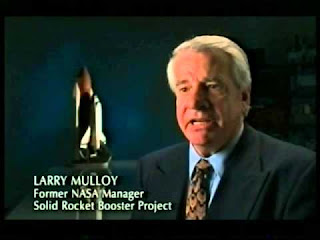 |
| The Challenger Crew |
Not too long ago, I was reminded that it was the thirtieth anniversary of the day that the Space Shuttle Challenger was lost to a disastrous explosion shortly after takeoff. Five years ago, I wrote on this blog of the strange connection I had with that event. I described how I ended up working for Larry Mulloy, the former NASA Program Manager of the Solid Rocket Booster (SRB) Program Office. What I didn't describe is the work that I performed as a result of that relationship.
For example, there was a 17" quick-disconnect valve that resided between the external tank and the orbiter. Fuel flowed through this valve during the ascent portion of the flight during which the main engines were operating. This valve had experienced a couple of random failures during tests. There was also talk of some crack development in the turbine blades of the main engines observed in testing. Who knows whether this was based on fact or not? And there were rumors of other technical issues.
So the o-ring problem that resulted in the Challenger disaster may have been the first problem that actually resulted in a catastrophic failure. And when that event took place, several engineering managers in the NASA organization could suddenly breathe a sigh of relief. They had been granted some time within which to reexamine some serious design issues and possibly concerns. Perhaps equally important, their system wasn't the one that would forever be linked to the loss of a shuttle and its precious cargo of astronauts.
What I learned, walking the halls of Marshall Space Flight Center with Larry Mulloy, was that a lot of NASA managers had a feeling of gratitude that he was the one who "took the fall." He had taken the early retirement. His judgement had been called into question. He had been the one in the headlines, the one who had testified before the congressional committees. And so, in some bizarre way, some of them believed they owed Larry Mulloy a debt of gratitude.
The next thing I knew, Cockerham & Associates had a contract from Marshall Space Flight Center to develop a schedule and conduct risk analysis on NASA's newly organized "Return to Flight" program. This benefited me, since scheduling and risk assessment were two of my strong suits professionally. I worked with a gentleman named Jules R. "Rick" Powers, who was the best I had ever encountered at programmatic analysis. Rick was an expert in the use of Artemis, a mainframe-based planning and scheduling tool that was the industry standard at the time. Rick Powers and I became the lead schedulers on NASA's return to flight, and that became one of the greatest professional challenges I've ever faced.
We met with many senior NASA executives, managers and former managers to conduct interviews. Access was never a problem. We had Larry Mulloy to get us in the door. Rick and I gradually put together the pieces of a very large puzzle. NASA management had decided that they needed to review every bit of the design documentation of the shuttle program. This included a revisiting of design, Failure Modes and Effects Analyses, Critical Item Lists, and supplier records. In order to schedule these reviews, we had to determine how many documents were involved and where they were located. Most existed in paper format and had never been digitized. Some were in NASA archival repositories. Some were lost. Some were misplaced. It was a remarkably difficult scheduling job, but Rick and I pressed on until we had developed a credible plan. Eventually, NASA personnel took over the maintenance of the schedules.
About a year later, I took on a proposal-writing job at Rockwell's headquarters in Downey, California. The work took place in a huge building that had served during WW II as the production building for PBY aircraft. One day I noticed a huge room full of individuals at desks who obviously weren't working on the project I was involved in. I asked my supervisor what those people were working on. He informed me that they were revisiting the Failure Modes and Effects Analyses of the Space Shuttle program (Remember, Rockwell had built the orbiters.). He didn't have to tell me any more than that. I knew exactly what that was all about.











